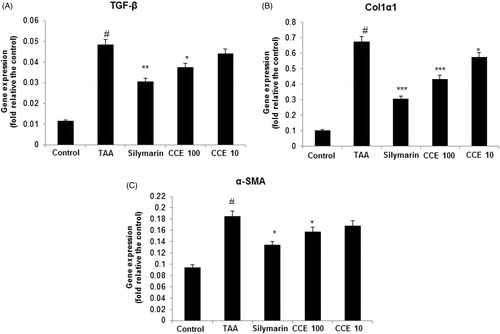Figures & data
Figure 1. Cell viability assay on Chang liver/HSC-T6 cells and morphological changes in primary HSCs on treatment with CCE. (A) Chang liver and HSC-T6 cells were incubated with CCE at indicated concentrations for 24 h and the cell viability was determined by MTT assay. (B) Primary HSCs were cultivated for 1 week and exposed to the CCE 0.1 mg/mL for 24 h (C). Pictures were taken after 24 h treatment with CCE. Magnification was 100×. Arrows indicate HSCs. The data are expressed as means ± S.E.M. (n = 10), using one-way analysis of variance (ANOVA) followed by Student’s t-test. #p < 0.05, compared with control group. NS: not significant compared with control group.
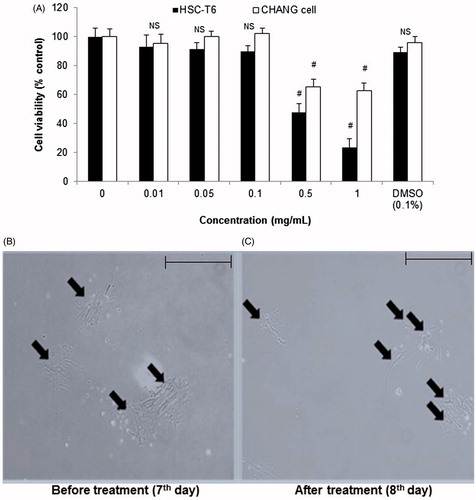
Figure 2. Effect of CCE on the cell cycle in HSC-T6 cells. DNA contents in different phases of the cell cycle were measured using propidium iodide by flow cytometry. The cell cycle distribution and the percentage of the cell cycle distribution were represented by histogram (left) and graphs (right), respectively.
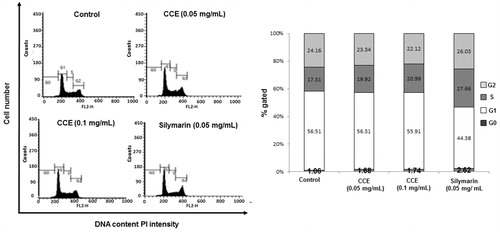
Figure 3. Effect of CCE on apoptosis in activated HSC-T6 cells. (A) Control cells. Flow cytometric data indicate apoptosis in HSC-T6 cells after incubation with CCE 0.05 mg/mL (B), CCE 0.1 mg/mL (C) and silymarin 0.05 mg/mL (D) for 24 h. E: Data showed the apoptotic (Annexin V+ and PI−) and late apoptotic (Annexin V+ and PI+) cells. Data are represented as mean ± S.E.M. (n = 10) using one-way analysis of variance (ANOVA) followed by Student’s t-test. *p < 0.05 and ***p < 0.001, as compared with control group.
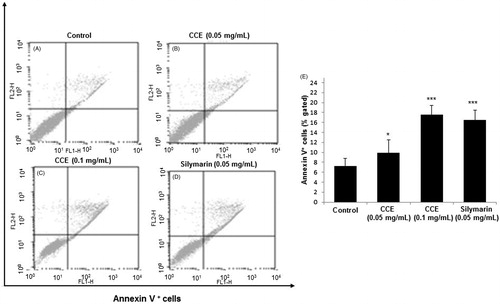
Figure 4. Effect of CCE on AST/ALT levels, total glutathione (GSH) contents and hydroxyproline levels in TAA-induced liver fibrosis rats. (A) HSC-T6 cells were incubated with CCE and silymarin for 24 h. Levels of AST (A) and ALT (B) in serum were measured using spectrophotometry. Total GSH contents (C) and hydroxyproline levels (D) in liver tissues were measured using spectrophotometry. TAA (200 mg/kg): thioacetamide-induced liver fibrosis rats, silymarin (50 mg/kg): positive control rats, CCE 100: CCE 100 mg/kg treated rats, CCE 10: CCE 10 mg/kg treated rats. The data are expressed as means ± S.E.M. (n = 10) using one-way analysis of variance (ANOVA) followed by Student’s t-test. #p < 0.05 as compared with control group, *p < 0.05, **p < 0.01, ***p < 0.001 as compared with TAA group.
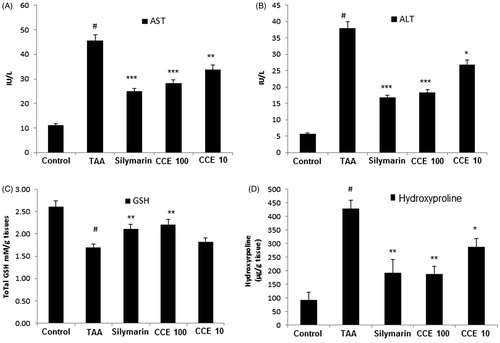
Figure 5. Haematoxylin and eosin (H&E) stain of liver tissues. At the end of the experiment, all of the animals were sacrificed and livers were fixed in Bouin’s solution. After staining with H&E, liver sections were taken under light microscopy. Control (A), TAA (200 mg/kg): TAA-induced liver fibrosis rats (B), silymarin (50 mg/kg): positive control rats (C), CCE 100: CCE 100 mg/kg treated rats (D), CCE 10: CCE 10 mg/kg treated rats (E). Scale bar =200 μM.
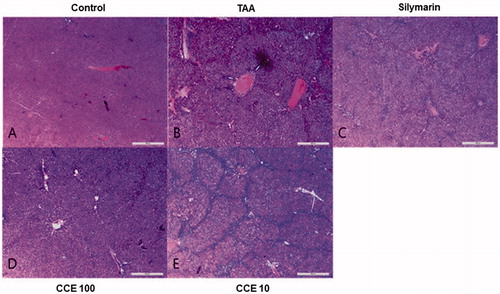
Figure 6. Masson’s trichrome staining of liver tissues. This stain was performed like H&E staining. Control (A), TAA (200 mg/kg): TAA-induced liver fibrosis rats (B), silymarin (50 mg/mL) (C), CCE 100 (D), CCE 10 (E) and fibrosis area plot (F). Scale bar = 200 μM. Quantification was done using ImageJ. Values are represented as mean ± S.E.M. (n = 10) using one-way analysis of variance (ANOVA) followed by Student’s t-test. #p < 0.05 as compared with control group, *p < 0.05, **p < 0.01 and ***p < 0.001 as compared with TAA group. TAA: thioacetamide-induced liver fibrosis rats, silymarin: positive control rats, CCE 100: CCE 100 mg/kg treated rats and CCE 10: CCE 10 mg/kg treated rats.
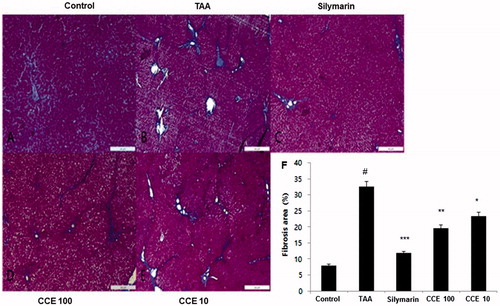
Figure 7. Fibrosis related gene expression analysis in the liver tissues. Fibrosis related gene expressions of liver tissue were determined by real-time-polymerase chain reaction (RT-PCR). A: TGF-β, B: Col1α1 and C: α-SMA. The results are expressed as normalized fold values relative to the control. Values are represented as mean ± S.E.M. (n = 10) using one-way analysis of variance (ANOVA) followed by Student’s t-test. #p < 0.05 compared with control group. *p < 0.05, **p < 0.01 and ***p < 0.001 as compared to TAA group. TAA (200 mg/kg): thioacetamide-induced liver fibrosis rats, silymarin (50 mg/kg): positive control rats, CCE 100: CCE 100 mg/kg treated rats and CCE 10: CCE 10 mg/kg treated rats.
